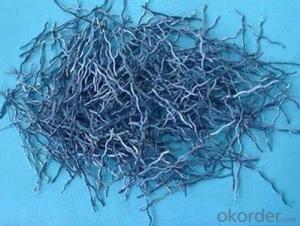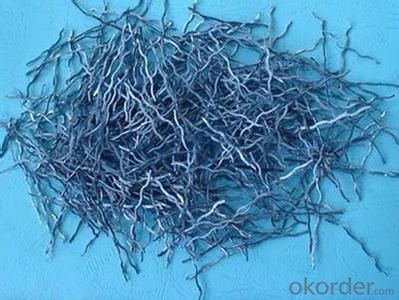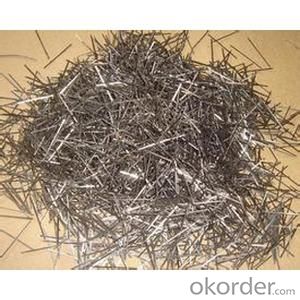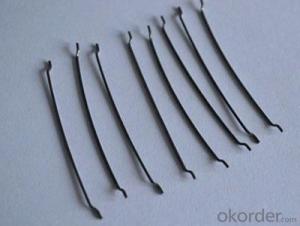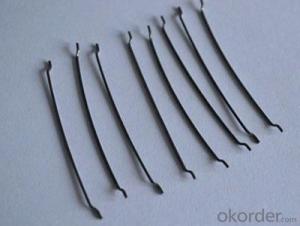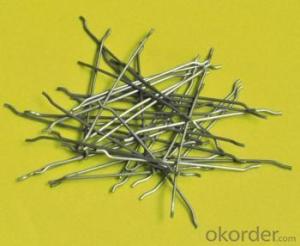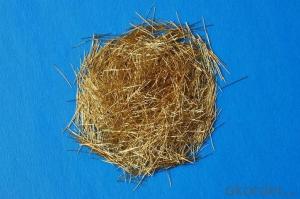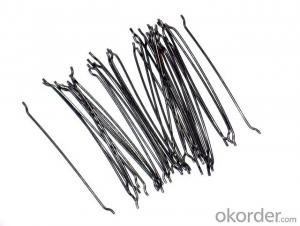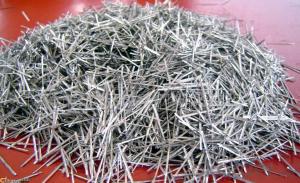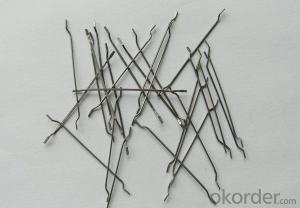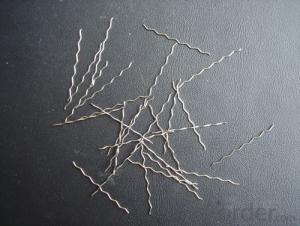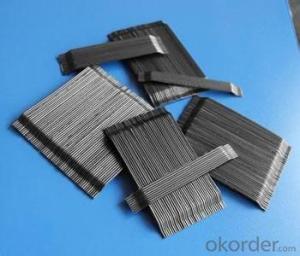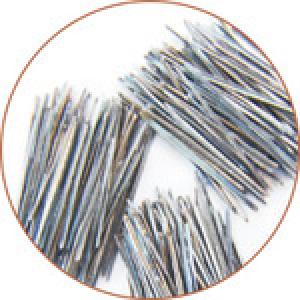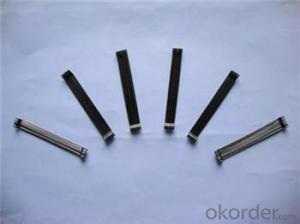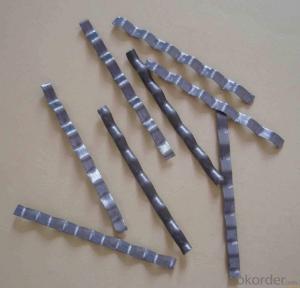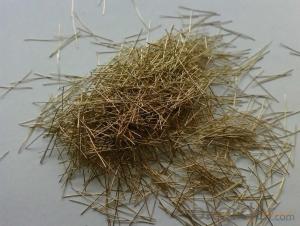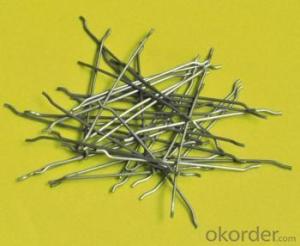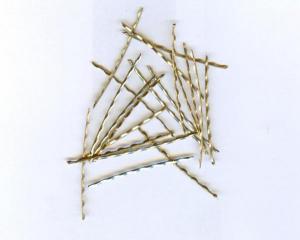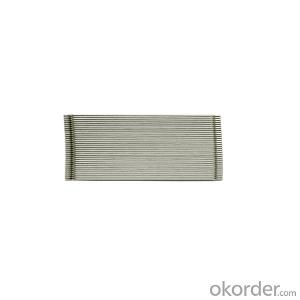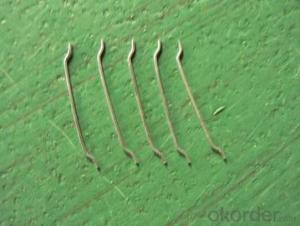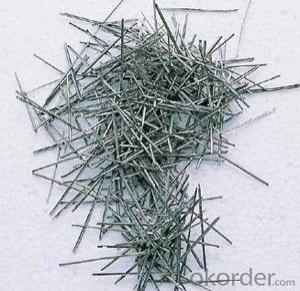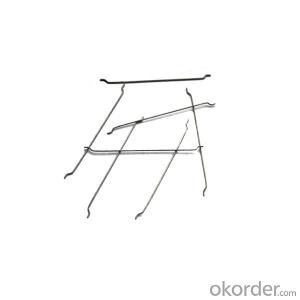Melt Extract Stainless Steel Fiber Reinforced Bending and Short Steel Fiber
- Loading Port:
- Tianjin
- Payment Terms:
- TT OR LC
- Min Order Qty:
- 5000 kg
- Supply Capability:
- 250000 kg/month
OKorder Service Pledge
OKorder Financial Service
You Might Also Like
Quick Details
Dimensions: steel wire
Grade: steel wire
Application: for concrete reinorcement
Shape: clear and bright
material: steel wire
type: wavy steel fiber
shape: corrugated flat fiber
usage: concrete reinforcement
appearance: clear and bright
Place of Origin: Shandong, China (Mainland)
Product features
steel fiber are for concrete construction, greatly improves concrete bonding and tensile strength .
concrete steel fiber is specially designed to enhance concrete in it`s hardened state ,the uniform distribution of steel fibers throughout the concrete greatly improves concrete bonding and tensile strength ,additionally it provides exceptional load stability and durability .
as reliable and efficient concrete reinforcement material ,it is widely uesd in buildings ,bridges ,thin roof engineering ,highway etc.
Specifications
Diameter :0.5-1.2mm
Tensile strength :≥1100Mpa
Length :20-60mm
properties :excellent tensile ,high tenacity ,against cracking and fatigue
type :any type we can produce according to your request
Picture
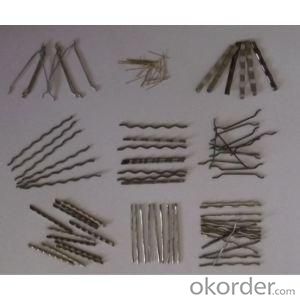
steel fiber concrete reinforced
FAQ
we can produce any type steel fiber and of course we can make production according to your requirement
we have specilize in this field for almost 10 years ,with good quality and competitive price
- Q: Can melt extract stainless steel fiber be used in blast-resistant concrete structures?
- Yes, melt extract stainless steel fiber can be used in blast-resistant concrete structures. The use of stainless steel fibers enhances the strength and durability of concrete, making it more resistant to the impact and pressure generated by explosions. The fibers provide additional reinforcement to the concrete matrix, preventing crack propagation and enhancing the overall structural integrity of blast-resistant concrete structures.
- Q: What is the effect of melt extract stainless steel fiber on the plastic settlement of shotcrete?
- The impact of melt extract stainless steel fiber on the plastic settlement of shotcrete cannot be underestimated. The inclusion of these fibers in the shotcrete mixture not only enhances its overall performance but also mitigates the issue of plastic settlement. Shotcrete is widely utilized in construction due to its rapid and efficient application. Nevertheless, it is susceptible to plastic settlement, which occurs when the material sinks or settles before it solidifies. This settlement can lead to undesirable outcomes such as cracks, voids, and weakened strength in the shotcrete. To combat this problem, melt extract stainless steel fibers have been specifically developed. These fibers are incorporated into the shotcrete mix and uniformly disperse throughout the material during the application process. As the shotcrete settles, the stainless steel fibers act as a reinforcement, providing additional support and preventing excessive settlement. The introduction of stainless steel fibers significantly enhances the tensile strength of the shotcrete, thereby augmenting its resistance to cracking and deformation. These fibers establish a three-dimensional network within the material, bolstering its overall structural integrity. Consequently, the plastic settlement of shotcrete is substantially reduced, ensuring that it maintains its form and strength during the setting process. Moreover, melt extract stainless steel fibers also contribute to the durability and longevity of shotcrete. They serve as a preventive measure against the formation of shrinkage cracks and offer added protection against external factors such as temperature fluctuations, moisture, and chemical exposure. To sum up, the incorporation of melt extract stainless steel fibers into shotcrete yields a positive impact on its plastic settlement. These fibers fortify the material, diminish settlement, and enhance its overall performance, durability, and strength.
- Q: What is the recommended testing procedure for melt extract stainless steel fiber in concrete?
- To effectively test the melt extract stainless steel fiber in concrete, the following steps are recommended: 1. Prepare a representative sample of the concrete mixture, ensuring that the fiber content aligns with the desired dosage for the actual application. 2. Achieve uniform distribution of the stainless steel fibers throughout the concrete mixture by thoroughly mixing the sample. This can be done either using a concrete mixer or by hand mixing. 3. Pour the mixed concrete into the designated mold or testing apparatus, making sure that the mold is adequately prepared and cleaned to avoid any interference with the test results. 4. Allow the concrete specimen to cure under controlled conditions for a specified time period. This involves maintaining a consistent temperature and humidity level to promote proper hydration and strength development. 5. Once the concrete has sufficiently cured, conduct the necessary tests to assess the performance of the melt extract stainless steel fiber. Common tests include evaluating compressive strength, flexural strength, and toughness. 6. Analyze the test results to determine how effectively the melt extract stainless steel fiber enhances the mechanical properties of the concrete. Compare the results with those of a control group without fiber reinforcement to evaluate the impact of the fiber on the concrete's performance. 7. Document the testing procedures, results, and any pertinent observations in a comprehensive report. Include details such as fiber dosage, curing conditions, and test methodologies to ensure reproducibility. It is important to recognize that the specific testing procedure may vary depending on the intended application and project requirements. Consulting relevant standards, guidelines, or industry best practices can provide more specific recommendations for testing melt extract stainless steel fiber in concrete.
- Q: The steel fiber concrete cover per cubic concrete how much steel fiber
- The design is specified, usually according to the total amount of cementitious material
- Q: What is the effect of melt extract stainless steel fiber on the drying shrinkage of concrete?
- Typically, the effect of melt extract stainless steel fiber on concrete's drying shrinkage is positive. These fibers are added to the concrete mix to help decrease overall drying shrinkage and the likelihood of cracks forming. During the drying process, concrete tends to shrink as the water evaporates. This shrinkage can create cracks, which can compromise the structure's strength and longevity. However, when melt extract stainless steel fibers are incorporated into the concrete mix, the shrinkage is significantly reduced. These fibers serve as reinforcement within the concrete, distributing stresses and strains more evenly. As a result, the chances of cracking during the drying process are reduced. Melt extract stainless steel fibers possess high tensile strength and excellent corrosion resistance, making them an ideal choice for this purpose. They also enhance durability and increase resistance to cracking caused by shrinkage and temperature fluctuations. To summarize, the addition of melt extract stainless steel fibers effectively minimizes drying shrinkage in concrete and decreases the risk of cracking. Consequently, it enhances the durability and longevity of the concrete structure.
- Q: How does melt extract stainless steel fiber improve the durability of concrete?
- Melt extract stainless steel fiber improves the durability of concrete by enhancing its resistance to cracking, spalling, and corrosion. The fibers act as reinforcement within the concrete matrix, increasing its tensile strength and preventing the propagation of cracks. Additionally, the stainless steel composition provides excellent resistance against corrosion, ensuring the longevity of the concrete structure.
- Q: Can melt extract stainless steel fiber be used in seismic-resistant concrete applications?
- Seismic-resistant concrete applications can benefit from the utilization of melt extract stainless steel fiber. These fibers, which possess high tensile strength, corrosion resistance, and the ability to disperse uniformly within the concrete matrix, are especially well-suited for this purpose. By reinforcing the concrete effectively and providing enhanced crack control, they mitigate the risk of structural failure during seismic events. Consequently, the incorporation of melt extract stainless steel fiber in seismic-resistant concrete significantly enhances the overall performance and safety of the structure.
- Q: How does melt extract stainless steel fiber affect the abrasion resistance of concrete?
- Melt extract stainless steel fiber significantly improves the abrasion resistance of concrete. The addition of these fibers enhances the overall durability and toughness of the concrete, making it more resistant to wear and tear caused by abrasion. The fibers reinforce the concrete matrix, thereby reducing the formation of cracks and increasing its resistance to surface abrasion.
- Q: Can melt extract stainless steel fiber be used in offshore platform construction?
- Yes, melt extract stainless steel fiber can be used in offshore platform construction. It offers excellent corrosion resistance, high tensile strength, and durability, making it suitable for the harsh offshore environment. Additionally, its ability to enhance the mechanical properties of concrete can improve the structural integrity and longevity of the platform.
- Q: Can melt extract stainless steel fiber be used in fiber-reinforced polymers (FRP)?
- Melt extract stainless steel fiber is applicable in fiber-reinforced polymers (FRP). FRP composites commonly employ stainless steel fibers to enhance mechanical properties like strength, stiffness, and toughness. During manufacturing, these fibers are typically added to the polymer matrix to improve the overall performance of the composite material. The excellent corrosion resistance, high tensile strength, and good thermal stability of melt extract stainless steel fibers make them suitable for applications where durability and reliability are crucial in FRP. Moreover, the presence of stainless steel fibers can also provide electromagnetic shielding properties to FRP composites, making them suitable for specific uses in industries such as aerospace or automotive. In summary, melt extract stainless steel fibers are effective in enhancing the mechanical and functional properties of fiber-reinforced polymers.
Send your message to us
Melt Extract Stainless Steel Fiber Reinforced Bending and Short Steel Fiber
- Loading Port:
- Tianjin
- Payment Terms:
- TT OR LC
- Min Order Qty:
- 5000 kg
- Supply Capability:
- 250000 kg/month
OKorder Service Pledge
OKorder Financial Service
Similar products
Hot products
Hot Searches
Related keywords
